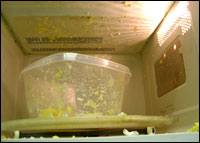Dear Umbra,
We recently bought a new (to us) house and acquired a microwave oven. Having gotten this far in life without one, we figured we wouldn’t use it all that much. Ha. We use it all the time. It’s just so much faster than heating things on the stove. I do wonder, though, which is more energy-efficient. Is it more eco-friendly to heat milk for a minute in the microwave, or five minutes on the gas stove? And is there anything to the persistent rumors of stray radiation from microwaves?
Z.B.
Pittsburgh, Penn.
Dearest Z.B.,
Microwaves and their ovens remind me of the 1980s. They were incredibly high-tech and cool back then and, like so much about the ’80s, they are safe when kept where they belong. Reaganomics and bi-level hair belong to history, and microwaves belong inside the microwave oven compartment, efficiently heating foods.

Plastic in the microwave: Don’t try
this at home.
Here’s what happens inside your new microwave oven: A “magnetron” element produces “microwave” band electromagnetic radiation, which bounces about on the oven walls. It penetrates food, hits the water molecules inside, and — I am not making this up — spins them around, causing them to rub up against one another. The food becomes heated as the rubbing spreads throughout, but the oven itself does not heat.
The magnetron only emits electromagnetic radiation when the oven is operating. When that minute and a half are over and the microwave dings, the magnetron shuts off, and the electromagnetism is over. Two separate locks must unlock to permit you inside the oven cavity for casserole retrieval. You’re in a science-fiction movie every time you use the oven. Only the double-locked vault protects you from the fury of Magnetron. Stay tuned to hear what happens if the door becomes … dented!
Microwave ovens are indeed more efficient than our familiar old friends, the electric and gas range/oven combos. In particular, they beat out ovens of both types. Not only are microwave ovens faster, they use electricity more efficiently (efficiency in this instance being a measure of energy going to the food versus energy wasted), because the magnetron doesn’t need to heat the ambient air.
But you asked about the stove top. This gets a little niggly. Microwaves are generally less efficient than electric stoves but more efficient than gas stoves. However, quantity makes a difference: If you crave just one cup of tea, the microwave oven would be a better choice than heating the habitual pot of water on either type of stove. Or, if you are a truly dedicated range user, you could carefully pour one mug’s worth of water into your kettle and heat only that. You’d be saving energy, except perhaps for your own energy you wasted on being niggly.
As for your last question — whether you should be worried about stray radiation — the U.S. Food and Drug Administration avers that radiation levels within two inches of standard microwave ovens are well below harmful standards. Two feet out, radiation is barely detectable. They also acknowledge, however, that no long-term studies have been done on exposure to these home appliance radiation levels.
As you probably know, some people don’t trust the FDA and its safety levels, so I’ll pass on some safety tips to use with your microwave. Don’t sit on it, straddle it, or lick it while it’s operating. Keep your distance. Teach kids how to use it safely. Use only glass or ceramic containers rather than plastic, to avoid potential leaching of chemicals into your foods. Don’t use a microwave with a mangled door seal, and don’t puncture or scratch the inside. Don’t operate it empty. Don’t overheat water; it’ll superheat and burble up to scald you. If your oven has an electronic display, unplug it when you’re not using it and you’ll save quite a bit of money over the year. Enough to go out to dinner!
Casseroly,
Umbra


